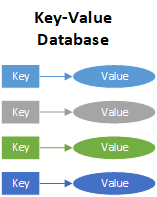Key-Value NoSQL Databases
Key-Value Database
 A key-value database, also known as a key-value store, is the most flexible type of NoSQL database. Key-value databases have emerged as an alternative to many of the limitations of traditional relational databases, where data is structured in tables and the schema must be predefined. In a key-value data store, there is no schema and the value of the data can be just about anything. Values are identified and accessed via a key, and values can be numbers, strings, counters, JSON, XML, HTML, binaries, images, videos, and more. It is the most flexible NoSQL model because the application has complete control over what is stored in the value field with no restrictions.
A key-value database, also known as a key-value store, is the most flexible type of NoSQL database. Key-value databases have emerged as an alternative to many of the limitations of traditional relational databases, where data is structured in tables and the schema must be predefined. In a key-value data store, there is no schema and the value of the data can be just about anything. Values are identified and accessed via a key, and values can be numbers, strings, counters, JSON, XML, HTML, binaries, images, videos, and more. It is the most flexible NoSQL model because the application has complete control over what is stored in the value field with no restrictions.
A key-value database is a simple database that contains a simple string (the key) that is always unique, and an arbitrary large data field (the value). Key-value stores have no query language, but they do provide a way to add and remove key-value pairs. Additionally, values cannot be queried or searched upon. Only the key can be queried. Within a key-value database, only three functions can be executed (put, get, delete).
• Put: Adds a new key-value pair and updates the value if the key is already present.
• Get: Returns the value for any given key.
• Delete: Removes a key-value pair.
 One of the benefits of the key-value database is that data of any data type can be stored in the value field including a binary large object (BLOB) value. Additionally, the key-value database is like a dictionary, as a dictionary has a list of words and each word has one or more definitions with various length. And like a dictionary, the key-value database is uniquely indexed by the key field. Thus, rapid retrieval of values can occur regardless of the number of records / items within the database. Key-value databases work in a very different fashion from traditional relational database management systems (RBMS). Traditionally RDBMS define data structures in the database as a series of tables containing fields with well-defined data types. In contrast, key-value databases treat data values as a single opaque collection, which may have different fields for every record. This offers considerable flexibility and more closely follows modern concepts like object-oriented programming. Because optional values are not represented by placeholders or input parameters, key-value databases often use far less memory to store the same database, which can lead to significant performance gains.
One of the benefits of the key-value database is that data of any data type can be stored in the value field including a binary large object (BLOB) value. Additionally, the key-value database is like a dictionary, as a dictionary has a list of words and each word has one or more definitions with various length. And like a dictionary, the key-value database is uniquely indexed by the key field. Thus, rapid retrieval of values can occur regardless of the number of records / items within the database. Key-value databases work in a very different fashion from traditional relational database management systems (RBMS). Traditionally RDBMS define data structures in the database as a series of tables containing fields with well-defined data types. In contrast, key-value databases treat data values as a single opaque collection, which may have different fields for every record. This offers considerable flexibility and more closely follows modern concepts like object-oriented programming. Because optional values are not represented by placeholders or input parameters, key-value databases often use far less memory to store the same database, which can lead to significant performance gains.


Leave a Reply
Want to join the discussion?Feel free to contribute!